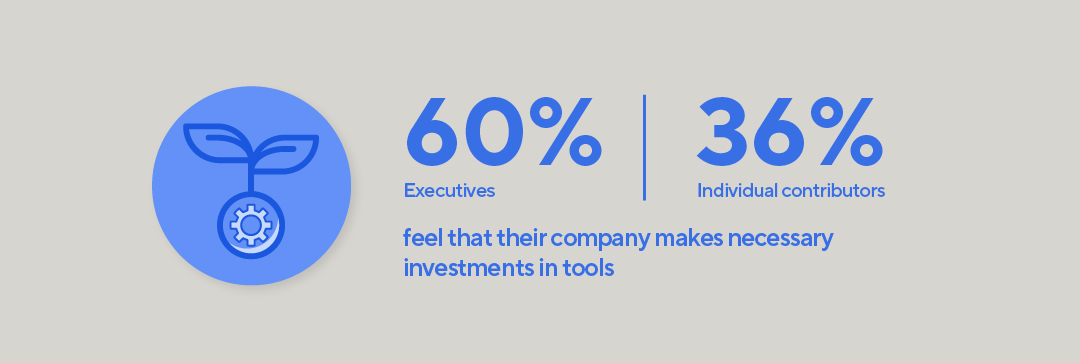Article
The disconnect between leadership and everyone else — and the strength of the managers in the middle
Senior leaders are responsible for having their pulse on a lot — economic headwinds, the ins and outs of their orgs, the cultural context in which they’re leading…and so on and so forth.
But when it comes to the work that happens day in and day out, those at the highest rungs are often viewed as out of touch, with little understanding of the planning, resourcing, and executing on work that’s being done. You may not find that surprising, but research in the Smartsheet Future of Work Management Report 2023 confirms it. The report reveals a huge disconnect between leaders overseeing the “middle work” and individual contributors actually executing on it. Teams view themselves as under-resourced, but leadership teams don’t see it that way: 60% of senior leaders say their company is making the necessary investments in the tools needed to address common project complications, but only 36% of non-C-level individuals say this is the case.
This article explores the strengths of the manager in the middle of the C-suite and front-line workers, and explores how to tap into those strengths to forge a path forward.
In praise of the managers in the middle
Let’s get the stigma out of the way right from the start. Middle managers have a bad rap: The generalization is that they enforce bureaucracy and push paper — Michael Scott from “The Office” comes to mind.
But let’s be clear here. The work of the manager in the middle is truly impactful. As a manager, you’re not just the link between the C-suite and everyone else. You’re also responsible for keeping track of your team’s work, motivating your people, and helping the greater group deal with burnout. You’re also tasked with retaining talent in addition to hiring and onboarding them. All in all, you’re the true crux of the organization.
You are the strategic link
As the strategic link, you have the vision to implement the strategies and skills to coach team members. You have the power to connect where the company is going with how your team contributes to larger, organizational-wide initiatives to drive strategy forward — particularly by reframing how you think about your role and how to solve organizational challenges.
Reframe how you think about what you do.
What do you say when someone asks what you do? You might answer that you lead your team, whether that be engineering or UX or whathaveyou. Reframing your answer to the question can transform how you approach work. That might look like “I drive x strategy” or “I facilitate change to accomplish y” and can help you better align with company goals.
Think through organizational challenges as if they’re your own.
There are some challenges and initiatives that are bigger than your purview, requiring multiple departments to work towards specific end goals in lockstep. The mental investment of thinking through their nuances can help you create goals and plans that align with larger business strategic goals — and makes you a valuable contributor.
These shifts will translate to creating initiatives that are more in sync with company-wide goals or OKRs, whether that’s contributing to company growth, rethinking how customers use our product, or driving demand.
You align your team’s strengths with the company’s goals
As a manager, you’re closest to the unique strengths of your team members. Odds are, they’re probably highly skilled in a specific area that your manager and your manager’s manager are less familiar with. The higher up the rung you go, the less familiarity with the details of how work actually comes to fruition.
This could potentially explain why, according to our Future of Work Management Report of 2023, 20% of C-suite leaders feel that project teams are typically understaffed while that number rises the closer it gets to the frontline of work: 36% of upper management, 41% of middle management, and 43% of people doing the work, such as individual contributors, frontline staff, and junior-level management feel understaffed.

As a manager, you’re able to see the big picture and you know what your teams need from a resourcing and support standpoint.
Unblock your team.
Traditionally, managers have been taught to measure hours spent on a task to determine efficiency, but the most impactful metric to focus on is actually outcomes. You can empower your teams to execute on their tasks by setting clear guidelines and identifying how their tasks roll up directly to the strategic goals of the business.
Make a concerted effort to support their efforts and remove blockers as much as possible so that they can accomplish both their tasks and their personal goals. They’ll feel more connected to the strategy of the organization and recognize the role their efforts play to accomplish company-wide goals.
You manage sideways
If you’re experiencing a challenge, it’s likely that one of your peers is experiencing something similar. Leveraging your shared experiences to collaborate and create alignment throughout the organization — a.k.a managing sideways — can serve as a catalyst for change you’d like to see.
Share ideas and listen to the concerns of your peers.
Regular one-on-ones create space to ask questions and share frustrations so you better understand the plight of your teammates. Once you understand their needs and concerns, work jointly to address strategic issues by creating a strong narrative and a clear action plan to get buy-in from the leadership team.
The shared experience can transform into a rallying cry that helps develop a team’s skills, better fill resource gaps, or set the stage to more convincingly sell the C-suite on your needs. Your peers are your biggest allies.
You align with the leadership team using the tools you have at your fingertips
It may not be possible to meet everyone’s every need all at once, but it is possible to showcase exactly what it takes to make work happen. Detailing what it takes to bring an initiative from idea to reality can fill in some of the knowledge gaps for senior leaders, helping them get on the same page as you and your peers.
Show how your team spends their time.
One way to showcase how and where your team members spend their time is by documenting it. A document noting the average amount of time it takes to complete certain tasks and projects, or a matrix of existing processes can start to fill the knowledge gap between team members and upper management. That matrix can also help you create detailed deliverable schedules as part of your project plans. Rolling your matrixes and project plans into one place like Smartsheet — complete with dashboards for easy visibility into project status — will help close that gap and better connect strategy to your team’s work.
Track work with full transparency.
With platforms like Resource Management by Smartsheet, you can see your team’s capacity, giving full visibility to your leadership team on who’s working on what, what it takes to get work done, and who’s free to take on the next project. That way, your leadership team has a better sense of how long it takes to complete a task or projects. Platforms like Smartsheet facilitate communication and provide visibility with a click.
Measure everything.
You can’t improve something you don’t measure — nor can you make the case for more support when you don’t have a strong reason for it. Once you start measuring things like operational efficiency, how you’re tracking towards KPIs, or your direct report’s path to growth, you have a path to aligning teams and improving effectiveness.
Being able to show where work is and who’s doing what is not just about communicating all the great work your team’s doing, but it’s also about raising flags when there’s a risk to getting everything done or scaling efforts as business grows. In addition to this information, being able to think through how to mitigate risk can not only close the knowledge gap, but also show how you’re aligning to the overall goals and objectives of the organization.
Connecting the dots (and the people)
Communicating how you’re aligning to the overall goals and objectives of your organization, managing sideways, unblocking your team to do what they do best — these are just some of the strengths managers can tap into to close the gap between leadership and everyone else in the organization.
The theme we come back to over and over again is put yourselves in their shoes — whether that’s your manager’s manager, your colleague, or your direct report. This type of connection and forethought will forge alignment all the way up to top management. Closing that gap relies on providing a clear picture of the work happening, backed up with data that’s easily digestible to stakeholders and leaders. With all of that communication, data-showing, and internalizing of company challenges, consider connection as your unofficial KPI to help you to find a way forward — whether you’re managing up, down, or sideways.
From the disconnect with leadership to top trends and pain points, the Future of Work Management Report 2023 uncovers the current state of project management, as well as more actionable ways to approach project-based work to maximize success and the well-being of your employees.

